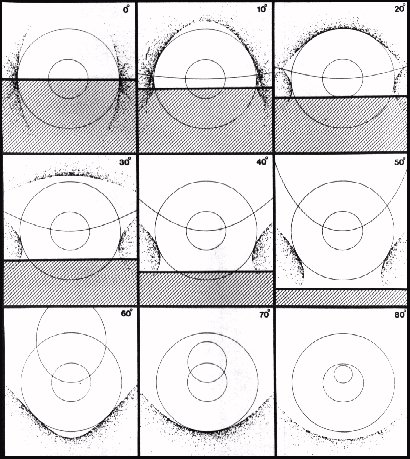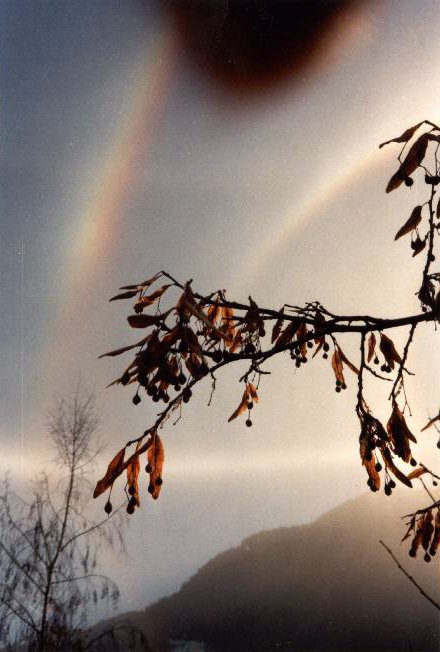- Crystal orientation:
- main axes horizontal
- Path of light:
- 3-2 / 3-1
- Occurrence:
- rarely
ca. once in a year
EE 21

Description:
A supralateral arc changes its appearance subject to the sun elevation. When the sun is lower than 15°, the supralateral arc touches the 46°-halo at its sides. When the sun is on the horizon, the contact points to the 46°-halo are at the same elevation like the sun. At sun elevations between 15 and 27 the supralateral arc almost overlaps with the 46°-halo, so that they are very difficult to be distinguished. In fact a lot of observations of the 46°-halo seem to have really been observations of the supralateral arc. Only at sun elevations between 27° and 32° the supralateral arc is significantly higher in the sky than the 46°-halo. A circumzenithal arc can also give a hint how to distinguish the supralateral arc from the 46°-halo, as it touches the supralateral arc at all sun elevations. At sun elevations between 15° and 27°, however, this is also valid for the 46°-halo. Another possibility how to distinguish the two halos from one another can he provided by the greater colourfulness of the supralateral arc. In most cases the 46°-halo is just white or has a faint reddish inner rim. The supralateral arc, however, is much more colourful. Blue and green are also visible well. It can even become as colourful and bright as a rainbow.

The diagram shows a computer simulation of the supralateral arc and of the infralateral arc at different sun elevations for a better orientation the 46°-halo, the 22°-halo and the parhelic circle are also drawn in. The supralateral arc is the arc which touches the 46°-halo at its sides and at its upper part. At sun elevations of more than 32° the supralateral arc cannot form. Thus, the diagram only shows the infralateral arc for sun elevations of 40° and more. The infralateral arc touches the 46°-halo at its lower side parts. Diagram taken from: R. Greenler; Rainbows, Halos and Glories; Cambridge University Press, 1980.
Formation:
A supralateral arc is caused by column-shaped ice crystals which are floating in the air. The light enters the vertical base face of the crystal and leaves a prism face. As the tangent arcs to the 22°-halo are also caused by column-shaped ice crystals, the appearing of a bright tanqent arc may be a hint for the arc above the 22°-halo being a supralateral arc and not a 46°-halo.
Characteristics of 46°-halo and supralateral arc
| Halos visible | 46°-halo | Supralateral arc | 46°-halo and supralateral arc |
|---|---|---|---|
| Common properties These features normally are appropriate to identify the halo in the 46°-region. If the halo still cannot be determined exactly by these properties, then also check the criteria for the corresponding sun elevation |
|
|
|
| Sun elevation less than 15° Supralateral arc touches 46°-halo at its sides. If the sun is near the horizon, contact arcs are at the same elevation like the sun. |
|
|
|
| Sun elevation between 15° and 27° Identification of both halos results difficult as both halos overlap |
|
|
|
| Sonnenhöhe 27 bis 32°
Halos don't touch themselve. |
|
|
|
| Sun elevation more than 32° Supralateral arc does not exist at sun elevations of more than 32° |
|
|
|


